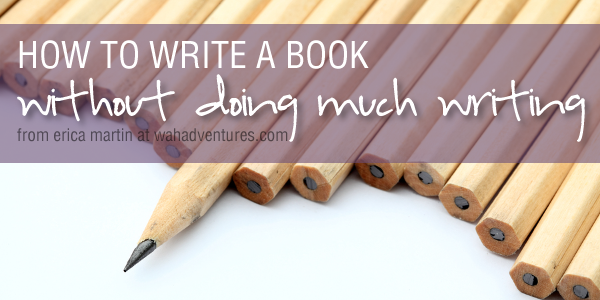How to Write a Book Without Doing Much Writing
Updated on: by Amy Kennedy
Create a Derivative Work from a Public Domain Work
If you’ve always wanted to write a book, but are not sure what you want to write about, there is good news. There is actually a way to write a book without necessarily doing a whole lot of writing .
Need Easy Extra $350+/Month For Free?
- SwagBucks: Watch videos, take surveys, shop and more to earn real money. Earn up to $35 per survey! No hidden fees and completely free. Join Swagbucks Now to Get $5 Free
- InboxDollars: Has so far paid its members over $40 Million. Watch videos, take surveys, shop and more. Join InboxDollars Now and Get Free $5
- SurveyJunkie: Make $5-$25 in your spare time from home to take online surveys, participating in a Focus Groups and trying new products. Join SurveyJunkie Now
- Branded Surveys: Complete online surveys. Collect points. Redeem your points for cash & gift cards. No hidden fees and completely free! Has so far paid its members over $18 Million. Join Branded Surveys Now
You can add to a book that’s in the public domain, or you can create a new book based on one that’s already in the public domain. This new book is called a derivative work.
This article will explain what a public domain work is, how to determine if a book is in the public domain, and also provide some examples of ways you can create derivative works from books in the public domain.
What is a public domain work?
A public domain work is a work that’s either no longer protected by copyright because the copyright has either expired, the copyright wasn’t valid because it didn’t follow certain rules, the work wasn’t eligible for copyright in the first place, or the creator dedicated it to the public domain.
How do you determine if a book is in the public domain?
There is no database that you can refer to to find out if a copyright is still valid, unfortunately, but as a general rule, if a book was published before 1923, it’s in the public domain – if it was published after 1963, it probably isn’t in the public domain – however if it wasn’t published without a proper copyright notice, it could. You can find out more about what a proper copyright notice is here at PublicDomainSherpa.com.
How long does copyright protection last?
This depends on when the work was published – if the work was published on or after January 1, 1978, then the copyright term is the author’s life plus 70 years. So, as an example, if I wrote a book and then died tomorrow, the copyright on my book would be good until July of 2083. However, if the work was published between January 1, 1924 and December 31, 1977, the copyright term is 95 years – so if a book was published on December 31, 1977, its copyright is good until December 31, 2072. However, there are other considerations, such as whether the work was a corporate work – to get a better idea on whether the copyright on a certain work is still in effect, use this copyright calculator or check out this diagram.
How can I create a derivative work once I’ve determined a book is in the public domain?
There are many different ways you can create a derivative work from a book that’s in the public domain. Some of them include:
- Writing a translation of a public domain work.
- Writing a screenplay based on a novel.
- Writing a biography of someone that contains their previously-published journals and letters.
- Writing a condensed version of a longer novel.
In order to qualify as a derivative work, it must use enough of the original work’s expression so that a reader will recognize that it’s based on a previous work. Merely borrowing ideas from a public domain work would not make the new work a derivative work.
What does the copyright for a derivative work cover?
Only the new material that’s added to a derivative work is entitled to copyright protection – that means the original work that the derivative work is based on is still in the public domain. However, if someone else were to create another derivative work that was substantially like another derivative work based on the same public domain work, then the copyright of the first derivative work would have been infringed upon, and the author of the original derivative work could press charges.
What are the rules for publishing derivative works on Amazon or other self-publishing sites?
As far as publishing on Amazon, I was unable to get a good idea on what their rules were regarding publishing derivative works – my suggestion for someone who wants to write a derivative work is to first check and see if the book you want to write has already been published on Amazon, or whatever site you want to publish on. If it hasn’t, it’s probably safe for you to go ahead and publish the derivative work.
Which are the self-publishing sites Like Amazon?
If you are looking to self-publish, there are other credible sites, other than Amazon. Such include:
1. Smashwords
Smashwords is a self-publishing platform and distributor that supports a variety of ebook formats. Authors maintain complete control over their work, including pricing and sampling. Smashwords also distributes books to major retailers such as Apple Books, Barnes & Noble, and Kobo, increasing the potential audience.
2. Draft2Digital
Draft2Digital provides a simplified self-publishing process. Authors can format and publish their books with ease, and the platform also helps in distributing the published work to major online retailers, including Amazon, Barnes & Noble, Kobo, and Apple Books. In addition to ebook formats, Draft2Digital also supports print-on-demand services.
3. Lulu
Lulu is a versatile self-publishing platform that supports both ebooks and print books. Lulu offers a user-friendly interface that guides authors through the publishing process, from formatting and cover design to distribution and marketing. It also has a global retail network that helps authors reach readers worldwide.
4. Blurb
Blurb is a unique platform that not only supports traditional book publishing but also specializes in photo books, magazines, and other visual content. It offers design tools and templates to help authors create professional-quality books. Blurb also features direct selling to customers and distribution to major retailers, including Amazon.
5. IngramSpark
IngramSpark is a comprehensive platform that supports ebooks, print books, and even audiobooks. It’s a great choice for authors seeking wide distribution, as IngramSpark’s network reaches over 39,000 retailers and libraries across the globe. This platform does charge setup fees, but the broad distribution and high-quality printing options often make it worth the cost for many authors.
Need Easy Extra Cash?
Pinecone Research, a leading name in online survey panel honesty, absolutely guarantees $3 cash for every survey you complete!
Take advantage of their time limited New Membership drive and register NOW. Join today: 100% free!
Join Pinecone Research Now
I hope this post has provided you with a good introduction to copyright law and some ideas for the types of derivative works that can be written. If you’ve had any experiences publishing books based on other books in the public domain I’d love to hear them!
Related Posts:
- How to Choose a Blog Domain Name- Blogging 101
- How to Add your Domain Name to Blogger- Blogging 101 Series
- How to Create a Profitable E-book and Sell It Online
- How to Buy Your Own Domain Name
- How to Write for the Yahoo! Contributor Network
Earn Everything… nearly!
Join Ipsos iSay, one of the few Faithful and Honest survey panels and earn prizes, gift cards and donations. Stack your points and redeem them: Simple! No hidden fees and completely free!
























Comments
Click here to post a comment...
Post comment
Terry
December 2, 2017 at 6:15 am
Their little “density” thing hasn’t been updated in two-years. Plus there’s comments on here of people not getting paid so I think I’m going to take a pass.